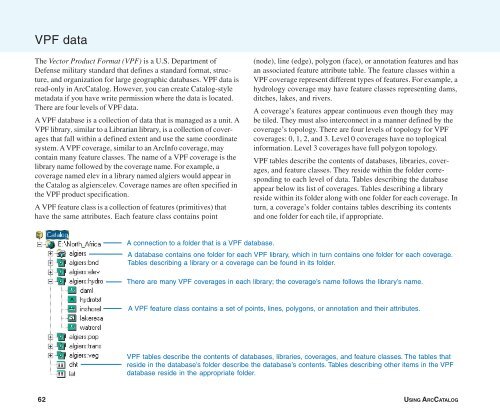Using ArcCatalog
Using ArcCatalog
Using ArcCatalog
You also want an ePaper? Increase the reach of your titles
YUMPU automatically turns print PDFs into web optimized ePapers that Google loves.
VPF data<br />
The Vector Product Format (VPF) is a U.S. Department of<br />
Defense military standard that defines a standard format, structure,<br />
and organization for large geographic databases. VPF data is<br />
read-only in <strong>ArcCatalog</strong>. However, you can create Catalog-style<br />
metadata if you have write permission where the data is located.<br />
There are four levels of VPF data.<br />
A VPF database is a collection of data that is managed as a unit. A<br />
VPF library, similar to a Librarian library, is a collection of coverages<br />
that fall within a defined extent and use the same coordinate<br />
system. A VPF coverage, similar to an ArcInfo coverage, may<br />
contain many feature classes. The name of a VPF coverage is the<br />
library name followed by the coverage name. For example, a<br />
coverage named elev in a library named algiers would appear in<br />
the Catalog as algiers:elev. Coverage names are often specified in<br />
the VPF product specification.<br />
A VPF feature class is a collection of features (primitives) that<br />
have the same attributes. Each feature class contains point<br />
(node), line (edge), polygon (face), or annotation features and has<br />
an associated feature attribute table. The feature classes within a<br />
VPF coverage represent different types of features. For example, a<br />
hydrology coverage may have feature classes representing dams,<br />
ditches, lakes, and rivers.<br />
A coverage’s features appear continuous even though they may<br />
be tiled. They must also interconnect in a manner defined by the<br />
coverage’s topology. There are four levels of topology for VPF<br />
coverages: 0, 1, 2, and 3. Level 0 coverages have no toplogical<br />
information. Level 3 coverages have full polygon topology.<br />
VPF tables describe the contents of databases, libraries, coverages,<br />
and feature classes. They reside within the folder corresponding<br />
to each level of data. Tables describing the database<br />
appear below its list of coverages. Tables describing a library<br />
reside within its folder along with one folder for each coverage. In<br />
turn, a coverage’s folder contains tables describing its contents<br />
and one folder for each tile, if appropriate.<br />
A connection to a folder that is a VPF database.<br />
A database contains one folder for each VPF library, which in turn contains one folder for each coverage.<br />
Tables describing a library or a coverage can be found in its folder.<br />
There are many VPF coverages in each library; the coverage’s name follows the library’s name.<br />
A VPF feature class contains a set of points, lines, polygons, or annotation and their attributes.<br />
VPF tables describe the contents of databases, libraries, coverages, and feature classes. The tables that<br />
reside in the database’s folder describe the database’s contents. Tables describing other items in the VPF<br />
database reside in the appropriate folder.<br />
62 USING ARCCATALOG

















